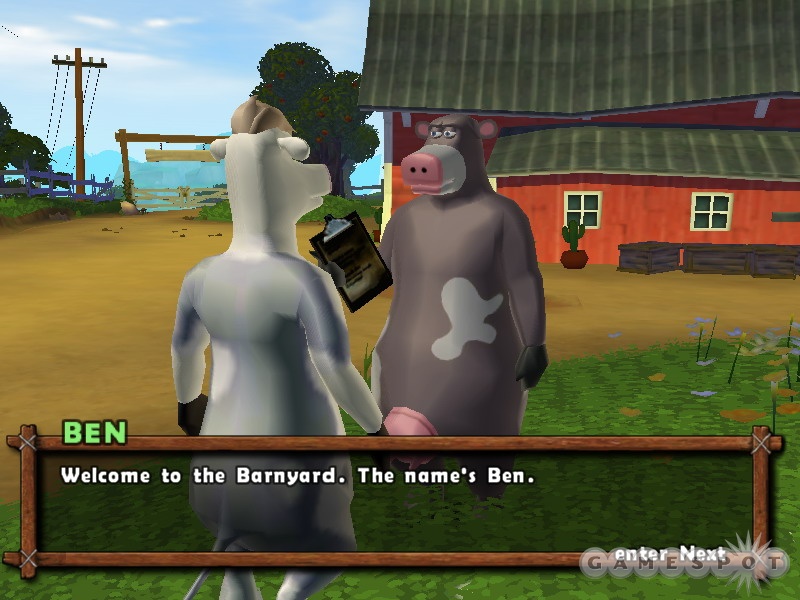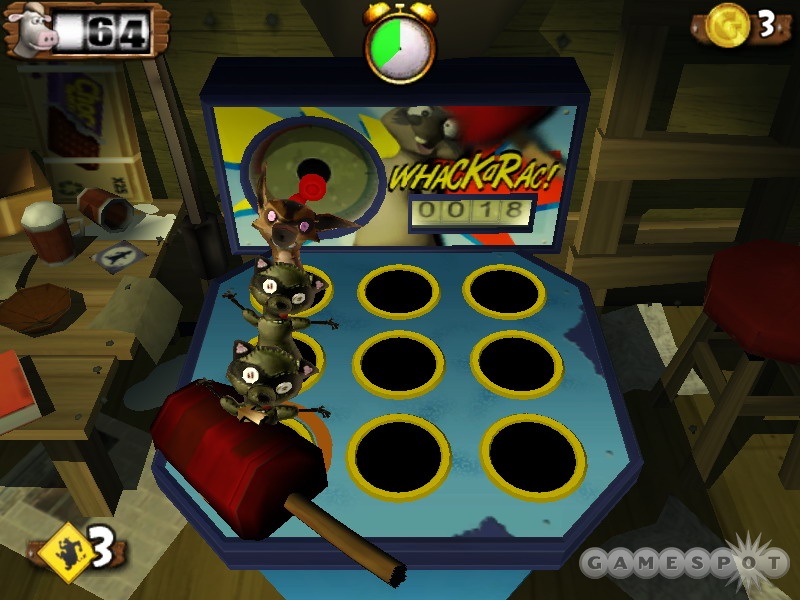THQ's Barnyard isn't like the majority of movie-inspired games. Instead of leading players through a series of missions that simply duplicate the film's story, it lets them explore the farm and tackle a wide variety of missions, minigames, and collect-a-thon checklists on an open-ended basis. Fans of the movie can experience firsthand what it's like to be a hip and happening cow. They can talk to their favorite characters, visit their favorite places, furnish the barn with the stuff they like, and do everything that Otis and his buddies did on the big screen. None of the missions or minigames here are all that unique or challenging, but that isn't such a big deal since most players will be too busy giggling at the charming anthropomorphism underpinning each one to really care that they're burning up the high-score chart.

The game, just like the movie did, depicts the farm as a bizarre place where animals behave like people. In this three-dimensional fantasy world, cows, chickens, and other livestock hang around and chat as if they were teenagers hanging out at the local mall. Otis, a carefree cow, likes to swim in the pond and play gopher golf. His father, Ben, carries around a clipboard and keeps raccoons and coyotes at bay with his milk squirters. There's a chicken named Peck who dreams of flying, so he routinely has the other animals launch him out of a slingshot so that he can sail across the farm, usually to disastrous results. There's a pack of cows that likes to race their bikes and go joyriding in the local farmers' cars. Every day, just for grins, these same cows sneak up behind the mailman and mock him behind his back. Players are dropped right into the middle of this menagerie, taking on the role of a teenage cow that has just been delivered to the farm. This cow wants to make a good impression, so he (or she, depending on the choice made in the beginning) decides to join the animals in their activities and help out in any way possible.
All of those activities, and dozens more, are depicted either as minigame challenges or as point-to-point-style missions. Just by wandering around and talking to the other animals, players can play gopher golf, blast coyotes and raccoons with their squirt-gun-like udders, control Peck's journey as he sails through the air, dance the robot behind the mailman's back, and so on and so forth. The controls and complexity level for each minigame vary, but they're all generally straightforward and nontaxing. What they lack in difficulty, they make up for in sheer amusement value. A cow squirting milk at raccoons like Keanu Reeves in The Matrix is just plain wacky. Some characters have tasks they need help with, which typically involves bringing back a certain item or visiting multiple characters situated at various spots on the farm. Most missions only take a couple of minutes to complete. The reward for completing them is usually a cinematic scene advancing a loose subplot involving the raccoons and coyotes, along with some gopher bucks to spend at the store on gopher hill.
There's plenty to see and do here. The environment itself encompasses two farms and the surrounding areas. Players can walk around, climb ladders, pick flowers, and ride a bicycle to get around more quickly. A few daredevil tricks can be performed while riding the bike, for no practical purpose except that it's something else to do. Tree stumps in the environment are actually prize machines run by the gophers that spit out gopher bucks in exchange for prize tokens. At the barn, players can participate in parlor games and use the food items they've collected to make treats and mocktails, which can be given to the other animals or sold to the gophers for a huge profit. Numerous bike upgrades and barn decorations are available for purchase at the gopher shop. Although many of these decorations are purely for aesthetic purposes, some of them unlock additional parlor games, such as pool, darts, and whack-a-rac. A cell phone item makes it easy to remember which missions are available, and there are multiple notebooks to keep track of all the hints and recipes collected along the way. This is a lighthearted sandbox-style game where players can watch the hours zip away as they do whatever they want, whenever they want.
What is perhaps most important in the game is that the 3D world does a good job of making players feel like they're actually exploring the farm from the movie. The cel-shaded graphics and bright primary colors mimic the look of the animated film. Players can explore a number of familiar locations from the movie and watch or talk to their favorite characters, which are all large and expressively animated. At first glance, it doesn't appear that there's much happening in the environment, aside from animals walking around, but closer inspection reveals a wealth of subtle details just waiting to be noticed. The animals smile and blink when spoken to, bushes and flowers shake when characters walk through them, and dirt and leaves are kicked up at every turn. A glimpse of the sky reveals that the clouds are actually passing by up there, and that the sun, moon, and stars are making their appointed treks as the clock ticks. Numerous objects in the environment can be picked up or smashed, including fruit, rocks, boxes, hay bales, and flower pots. Trees can be kicked and ladders can be climbed. The world of Barnyard is quite vivacious. Throughout it all, the graphics engine never skips a beat. The textures and character models are sufficiently crisp, the frame rate remains smooth even when a bunch of animals and items are visible, and the draw distance is far enough such that only the occasional distant tree suddenly pops into view. As for the minigames, they vary in quality. Some are rather plain and recycle the same character models from the normal viewpoint. Others employ their own full-featured 3D engines and slick visual effects. In general, the more complex a minigame is, the nicer it's put together. Gopher golf, for example, could have been sold as a stand-alone game if it had more than the single nine-hole course.

The audio is similarly atmospheric. Just standing still, you can hear the wind blowing through the trees, the birds chirping, and the faint sound of water coming from the direction of the river. Every action, such as shaking fruit out of a tree or walking across a rickety dock, has the appropriate sound effect. The banjo music that's always playing in the background is rather fitting too. Despite all of this ambient detail, the audio often feels too subdued. The main reason is the lack of character speech in the game. Characters don't say much while wandering the farm or during minigames. Even during conversation scenes, each animal will only say its first line of dialogue, leaving the player to read the rest. It's rare that a movie tie-in has so little recorded dialogue, as that's usually a major selling point.
Anyone considering purchasing the PC version of the game may also want to keep in mind that its display output is locked at a resolution of 800x600 pixels, and that it doesn't support the use of gamepads or joysticks. Most people won't be bothered by the display resolution, since this isn't a first-person shooter requiring pixel-perfect aiming across huge battlefields. The lack of gamepad support is irksome at times, though, especially since the minigames seem to have been designed with gamepads in mind. The keyboard-and-mouse controls are fine for getting around in the world, but the minigames require ridiculous amounts of mouse-dragging and finger contortion. When it comes to controls, the PlayStation 2 and the GameCube versions definitely have a leg up on the PC game. Of course, the PC game costs half as much as the console versions do, and its graphics are slightly better in every regard.
In any event, fans of the movie will likely be pleased with how the video game rendition of Barnyard turned out. Its open-ended design is a breath of fresh air and many of the minigames are genuinely fun. Also, the overall presentation lives up to the movie's anthropomorphic sense of humor.